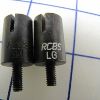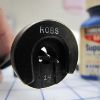I finally finished reading all 54 pages…. WOW, some great ideas.
I now have several new projects in mind.
Thanks guys.
Here are a few more of my ideas:
1. Back in the days when I was using just a single stage press, I recognized that there was a lot of arm movement involved and found ways to eliminate as much as I could.
First of all was placing each lubricated brass in the shell holder for resizing then reaching for another.
I started picking up two at a time, simply switching them in my hand between my thumb and index finger.
Naturally there was a learning curve involved, but I soon got to where I could size two brass almost as quickly as just one.
This evolved into sizing three brass for each reach of the arm. The third brass was held between the index and middle finger.
Again there was a learning curve involved, but I was soon sizing three brass for each arm reach.
I also attempted four brass at a time, but it proved to not be practical.
Charging cases with powder one at a time also showed a lot of wasted movement.
I sped up this process by mounting the powder measure over the edge of the bench and charging all the brass while still in the (Hurter’s tall rifle) loading block.
Because of the design of the stand, I would have to charge only three rows of brass and then turn the loading block around to charge the last two rows.
After a little practice I was charging cases at a very high rate.
A quick look using a flashlight to check uniformity of charge height and I was ready to seat bullets.
Note the mounting location.
Seating bullets more than one at a time required that I placed a bullet on each case before I started.
I got so I could balance two handgun bullets on top of their brass for each reach of the arm.
When using boat tail rifle bullets, I got so I could seat three for each reach.
Flat based rifle bullets were still seated one at a time.
2. I have made several modifications to my reloading bench.
See my report about it in the
Show us a picture of your reloading bench thread.
3. There have been more than a few good suggestions about Dillon equipment so far.
I’ll add this one for the Dillon powder measure.
Because of it’s location changing the charge on the Dillon powder measure is not really easy using an ordinary bench wrench.
So, I cut down an appropriate box end wrench to fit.
Adjustment wrench mounted on the powder measure.
The cut down wrench is long enough to have enough leverage to make very small adjustments and is still short enough to allow 360 degree turning for large ones.
Naturally, such a small item can quickly become lost among the tools on my reloading bench.
I modified the Dillon Allen wrench bracket mounted behind the XL650 press.
A hole was drilled and tapped for a cut down screw.
The screw was also supported by a nut on the back held tight with Super Glue.
Note the brass tube spacer.
Now it is always where I can find it.
4. Several people have suggested using a three ring notebook.
Because of the number of different cartridges that I reload, I have use a separate notebook for each cartridge.
This contains all my notes and reloading records for that cartridge.
There are several cartridges where I have also saved magazine articles referencing that cartridge in plastic page keepers
Steve


















 where is that backup???
where is that backup???


